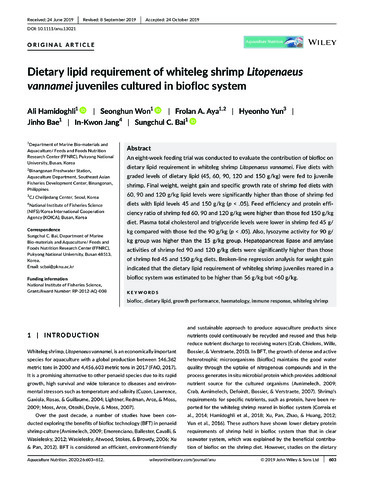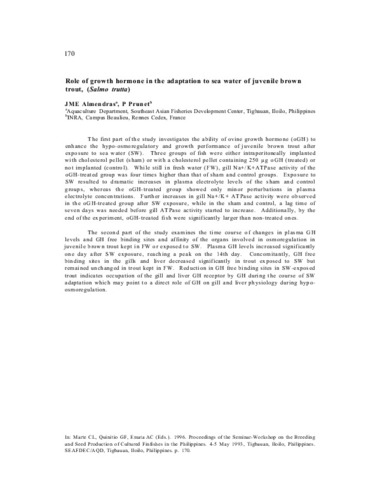Effects of alternate starvation and refeeding cycles on food consumption and compensatory growth of abalone, Haliotis asinina (Linnaeus).
- Global styles
- MLA
- Vancouver
- Elsevier - Harvard
- APA
- Help

View/Open
Date
2002Author
Page views
1,066AGROVOC keyword
Metadata
Perlihat publikasi penuhCited times in Scopus
- Citations
- CrossRef - Citation Indexes: 16
- Scopus - Citation Indexes: 17
- Captures
- Mendeley - Readers: 25
Share
Abstract
The effects of alternate starvation and refeeding on food consumption and compensatory growth of hatchery-bred abalone, Haliotis asinina (Linnaeus), were determined. Two groups of abalone juveniles (mean shell length = 29 mm, body weight = 5 g) were alternately starved and refed a macro-alga, Gracilariopsis bailinae at equal duration (5/5 or 10/10) over 140 days. A control group (FR) was fed the seaweed ad libitum throughout a 200-day experimental period. Starved and refed abalone showed slower growth rates (DGR, 63 and 70 mg/day in the 5/5 and 10/10 groups respectively), as a result of reduced food intake (DFI 15% and 16% day−1 respectively), after repeated starvation and refeeding cycles. Percentage weight gains (5/5 = 196%, 10/10 = 177%) were significantly lower than that of the control (397%). When refed continuously over 60 days, the starved groups exhibited increased DFI and fed at the rate of 24% and 25% day−1, which were not significantly different from that of the control at 26% day−1. At the end of the experiment, no significant differences were observed among three treatments in terms of shell length (range: 46–48 mm), body weight (range 25–28 g), % weight gain (392–465%) and per cent survival (range 87–98%). The results indicated that H. asinina had a complete compensatory growth following a return to full rations after a series of intermittent starvation and refeeding cycles.
Suggested Citation
Fermin, A. C. (2002). Effects of alternate starvation and refeeding cycles on food consumption and compensatory growth of abalone, Haliotis asinina (Linnaeus). Aquaculture Research , 33(3), 197-202. https://doi.org/10.1046/j.1365-2109.2002.00656.x
Type
ArticleISSN
1355-557XKoleksi
- Journal Articles [1247]
Related items
Showing items related by title, author, creator and subject.
-
Growth pattern of the tropical sea cucumber, Holothuria scabra, under captivity
Watanabe, Satoshi; Sumbing, Joemel; Lebata-Ramos, Ma. Junemie Hazel (Ministry of Tropical Agricultural Research Centre, 2014)
The growth of the juvenile sea cucumber, Holothuria scabra, was studied under captivity to elucidate the growth variation pattern and determine the best-fit growth model to estimate age- and size-specific growth rates. ...1919 Total citations3 Recent citations2.36 Field Citation Ration/a Relative Citation Ratio
(Ministry of Tropical Agricultural Research Centre, 2014)
The growth of the juvenile sea cucumber, Holothuria scabra, was studied under captivity to elucidate the growth variation pattern and determine the best-fit growth model to estimate age- and size-specific growth rates. ...1919 Total citations3 Recent citations2.36 Field Citation Ration/a Relative Citation Ratio
-
Dietary lipid requirement of whiteleg shrimp Litopenaeus vannamei juveniles cultured in biofloc system
Hamidoghli, Ali; Won, Seonghun; Aya, Frolan ; Yun, Hyeonho; Bae, Jinho; Jang, In-Kwon; Bai, Sungchul C. (Wiley, 2020-06)
An eight-week feeding trial was conducted to evaluate the contribution of biofloc on dietary lipid requirement in whiteleg shrimp Litopenaeus vannamei. Five diets with graded levels of dietary lipid (45, 60, 90, 120 and ...1515 Total citations6 Recent citations2.94 Field Citation Ration/a Relative Citation Ratio
; Yun, Hyeonho; Bae, Jinho; Jang, In-Kwon; Bai, Sungchul C. (Wiley, 2020-06)
An eight-week feeding trial was conducted to evaluate the contribution of biofloc on dietary lipid requirement in whiteleg shrimp Litopenaeus vannamei. Five diets with graded levels of dietary lipid (45, 60, 90, 120 and ...1515 Total citations6 Recent citations2.94 Field Citation Ration/a Relative Citation Ratio
-
Role of growth hormone in the adaptation to sea water of juveline brown trout, (Salmo trutta)
Almendras, J. M. E.; Punet, P. (Aquaculture Department, Southeast Asian Fisheries Development Center, 1996)The first part of the study investigates the ability of ovine growth hormone (oGH) to enhance the hypo-osmoregulatory and growth performance of juvenile brown trout after exposure to sea water (SW). Three groups of fish ...





